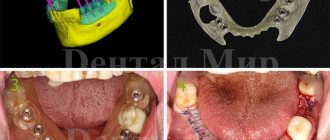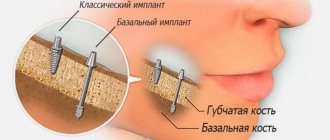Implantation is considered a quick, painless and reliable dental restoration procedure. Installation of one implant often takes no longer than half an hour and most often occurs under local anesthesia. However, in some cases, this surgical procedure is performed using general anesthesia. Dmitry Valerievich Levin, Candidate of Medical Sciences, chief physician and implant surgeon at the Doctor Levin Center for Private Dentistry in Moscow, talks about who needs dental implantation under anesthesia.
Sedation
Putting you into a shallow sleep with the help of medications is called sedation. The person breathes himself (which distinguishes this type of anesthesia from general), and responds to simple requests from the doctor. This relaxed state helps the patient get rid of anxiety, and the doctor calmly, as usual, performs all the necessary manipulations.
When is sedation appropriate?
Any specialist will tell you that anesthesia for dental implantation is not always necessary. Infiltration or conduction anesthesia can numb the implant site for a sufficient amount of time (up to 2 hours). This is quite enough to prepare the bed, introduce several artificial roots into the bone, and fix the prosthesis.
The use of implantation during sleep may be advisable if more treatment time is needed. In cases where preliminary bone grafting is planned, a large number of implants should be placed at a time and for other indications, which are described below.
Natural complications after implantation
In simple terms, implantation of titanium roots is a mechanical invasion of the human body. It is clear that this cannot happen without some consequences.
It is considered quite normal if after implantation a person feels pain in the oral cavity for 2 to 3 days. This pain is quite bearable. If after three days it has not subsided, then this indicates an inflammatory process has arisen.
A few hours after the operation is completed, swelling may occur in the patient’s mouth, and this is quite normal; our body does not react to a foreign object in any other way. With normal implant healing, this swelling disappears after a maximum of a week.
Light bleeding in the implant area is also considered completely normal. It can last up to 10 days. If this process drags on over time, then the reason for this is damage to the blood vessel.
Elevated body temperature is also considered normal. If for 2 - 3 days it remains at a level of 37 degrees and no higher, then you should not be afraid of this. If the temperature does not drop further or, worse, it increases, then this indicates inflammation.
Implantation under sedation or general anesthesia: which is better?
First, it’s worth understanding the terms in more detail. General anesthesia is a complete loss of consciousness in a person. The machine breathes for him, he does not react to stimuli or voice. This is a serious burden on the body and suppression of the nervous system. Quite often used for long abdominal operations in surgery, but in dental practice it is used extremely rarely.
Sedation is immersion in superficial sleep, while maintaining the person’s response (inhibited), for example, to the doctor’s commands. Consciousness does not turn off. Coming out of such anesthesia is easy and quick. Like after the usual morning awakening.
The patient decides which method to choose together with the doctor, based on the clinical picture, general health, and test results. But dental implantation under sedation is preferable. Without significant depression of the nervous system.
Indications for general anesthesia
- diseases of the central nervous system;
- severe conditions after injuries;
- vomiting reflex;
- dentophobia;
- Parkinson's disease;
- allergy to local anesthetics;
- immune system diseases;
- for extensive work - bone grafting, implantation of a large number of teeth, collection of donor bone material in the area of the ilium or skull.
Note! General anesthesia in dentistry is used in exceptional cases, when other methods are ineffective, or a person has objective indicators for general anesthesia. Anesthesia is a serious effect on the body, which should be used only in extreme cases, especially since the modern development of anesthesia offers a lot of alternative options.
How is implantation performed in a dream?
Before dental implantation, a consultation with an anesthesiologist takes place. An anamnesis is being collected. Older patients may be referred to a cardiologist.
On the appointed day:
- Falling into a sleepy state. A sedative is administered intravenously or gas is released through a mask. A butterfly catheter is installed on the wrist if resuscitation is necessary. Sensitivity is checked. Additionally, a drug for pain relief is administered.
- Implantation in a dream. The dentist-implantologist implants titanium pins, while the anesthesiologist monitors the indicators of respiration, heartbeat, blood pressure, and blood oxygen saturation on the monitor.
- Awakening. After completing the manipulations, the patient is taken out of sleep, a CT scan is done, they are allowed to rest in the rehabilitation ward for 20-40 minutes, and the condition is monitored.
- You can leave the clinic and go home.
Possible negative consequences after implantation
Unfortunately, although very rare, negative consequences also occur after implantation of titanium roots.
Sometimes, as a result of mechanical damage or an inflammatory process, patients' sutures come apart.
If the dentist's recommendations are not followed correctly, some patients experience infection between the artificial root and the gum. This inevitably leads to the emergence of a focus of inflammation.
In the rarest cases, the implant does not heal into the jawbone at all. The bone tissue simply rejects the foreign body from itself. In this case, the patient begins to experience increasing pain, and the implant itself begins to wobble. In this case, the implant has to be removed and the disturbed jawbone must be repaired.
Indications and contraindications for use
Main indications for sedation:
- dentophobia. The patient is not mentally prepared for treatment or even to come to the dental clinic. Sitting in a chair is his worst nightmare. People in white coats cause panic attacks;
- preliminary bone grafting or sinus lift;
- multiple implantations, installation of 5 or more implants;
- it is known in advance that the operation will last more than 4 hours due to the complexity of the individual case.
Contraindications to implantation during sleep:
- serious kidney and liver diseases;
- bronchial asthma;
- previous heart attack (less than 6 months ago);
- drug and alcohol intoxication;
- hormone therapy;
- diseases of the endocrine system, thyroid gland;
- children's age (up to 3 years);
- pregnancy.
Possible complications after general anesthesia
It should be said right away that the use of general anesthesia always causes some complications. This is a completely normal phenomenon, and you should not be afraid of them. The patient may experience discomfort while recovering from general anesthesia. Let's name them.
- A mild sore throat and dry mouth may be present for two days after surgery.
- For the first half hour after surgery, slight tremors may be observed in the body.
- The effect of general anesthesia is always accompanied by a decrease in blood pressure. Because of this, after waking up, the patient may feel dizzy and experience bouts of nausea.
- Some patients may experience itching. Its appearance is associated with a mild allergic reaction to medications.
- Older people may experience confusion during recovery from anesthesia.
- In rare cases, the patient awakens before the operation is completed. The reason for this is the anesthesiologist’s mistake when choosing the drug or its dose.
All of the above complications do not always occur and not in all patients. Their manifestation is associated with the individual characteristics of each person’s body.
Prices for dental implantation under sedation
Many centers perform implantation during sleep. The cost is quite high compared to traditional anesthesia. For the first hour the price can be 12,500 rubles. , for every next 30 minutes 6,000 rubles. RUB 48,500 separately for dental anesthesia
Of course, dental clinics use modern anesthetics with the safest composition. But it’s better to think, maybe it’s not worth overloading the body and testing its strength if local anesthesia has been proven to be sufficient.
Operation duration
It is installed by the operating surgeon together with the anesthesiologist-resuscitator. Directly depends on the volume of bone tissue, the condition of soft tissues in the working field, the number of implants planned for installation on the day of surgery, and the need for tooth extraction. Approximate boundaries:
| Scope of work | Hours of sedation |
| 1 implant | 1 hour |
| 2-3 implants | 2 hours |
| 4-6 implants | 3-4 hours |
| 7-15 implants | 5-6 hours |
| 16-20 implants | 7-8 hours |
| Sinus lift in the area of 1-2 teeth | 1 hour |
| Guided bone regeneration in the area of 2-3 teeth | 2 hours |
| Removal of 1 tooth | 1 hour |
| Gum plastic surgery in the area of 1 segment | 1 hour |
When is anesthesia used for implantation?
General anesthesia, or anesthesia, is a state of the human body in which consciousness, reflexes and pain sensitivity are temporarily disabled. The patient falls into a deep sleep, feels absolutely nothing, hears nothing and then does not remember.
Installation of implants under anesthesia is indicated in the following cases:
- the patient has severe dental phobia;
- allergy to drugs for local anesthesia;
- diseases of the central nervous system and mental pathologies;
- installation of a large number of implants with combined procedures.
To use anesthesia, a dental clinic must have the appropriate license and conditions, so not all dentists offer general anesthesia.
Content
- Types of anesthesia
- Implantation under anesthesia
- Implantation under general anesthesia
- Minuses
- Side effects
To implant an implant, anesthesia is required in any case, since a deep incision of soft tissue is made and work with bone tissue is performed. Dentists have many options when it comes to choosing the best anesthesia. It is cheaper and easier to use local anesthesia. As a rule, high-quality local anesthesia is the optimal measure when installing up to four implants.
The best and safest option is articaine anesthetics - modern drugs of medium action, providing a sufficient duration of anesthesia for most dental practices.
The most preferred agents for local anesthesia are articaine (ultracaine) and scandonest.
PROMOTION
Osstem dental implantation turnkey
18,000 rub.
In what cases is anesthesia still used?
In fact, there is not a single medical procedure for which anesthesia cannot be used. Even such a simple procedure as professional hygiene can be performed under local anesthesia, not to mention other dental treatments.
Anesthesia for dental prosthetics is used in cases where vital (living) teeth are grinded. Anesthesia is also used when trying on artificial crowns, when they are placed on living teeth. No anesthesia is required for implant prosthetics.
Life time
Our Center has been working exclusively with Nobel Biocare (USA) implantation systems since 2003
The company guarantees an indefinite service life of implants due to the maximum level of production control. According to the experience of our specialists, implants are included in the rejection statistics less often than all other implantation systems.
We are a Nobel Biocare Center of Clinical Excellence . This confirms that the failure rate of implants installed in our clinic over 10 years of operation does not exceed 2%.
Guarantees
A lifetime guarantee is provided for all surgical procedures without exception, incl. sinus lift and bone grafting
All specialists at our Center work in strict compliance with internal quality standards - from the patient’s first visit to annual preventive examinations. Therefore, we provide a lifetime guarantee not only for implants, but also for their installation in the LifeTime Warranty since 2003. Each patient receives a passport for installed implants.









